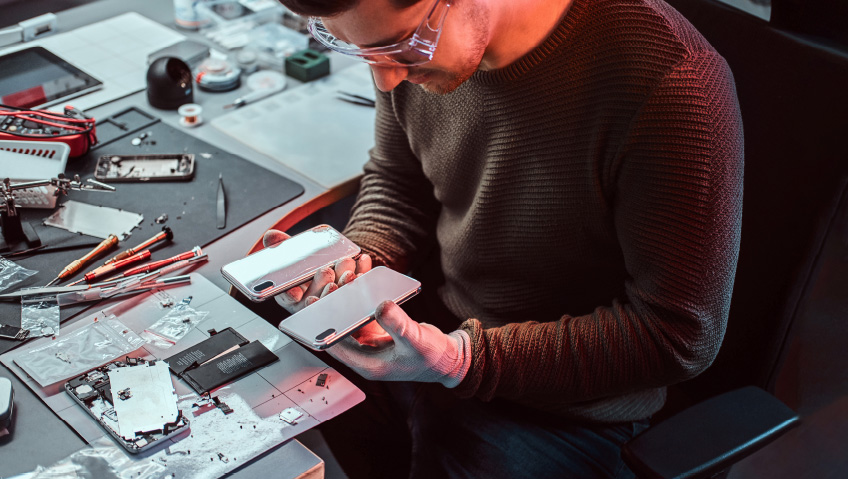Technology has given the world televisions, computers, monitors, printers, copiers, and smartphones, but also a new term for the growing mountains of dead electronics: e-waste. The issue of e-waste has sparked endless debates over what we can do to keep millions of discarded devices out of landfills, and this month, we look at the right to repair.
In the world of technology, the debate over which products are best is never-ending. In the pre-CD seventies—when vinyl was king—audiophiles raged over receivers, tuners, and turntables from manufacturers like Pioneer, Sherwood, Marantz, Telefunken, and Kenwood. Some brands, they insisted, were superior to others for spinning groundbreaking albums like The Who’s rock opera Quadrophenia, or Pink Floyd’s The Dark Side of the Moon. Even high-quality systems needed repairs or replacement parts, and repair shops were seemingly on every other corner.
By the eighties, debates about audio systems shifted toward home computers. Everyone from tech gurus to ordinary consumers jumped on the ‘Mac versus PC’ battle, with each side justifying their argument about everything from operating systems to processor speed, software, graphics, and more.
For years, all computers looked pretty much the same, boxy and beige, until Apple launched the iMac in 1998. It was the first big product release for the then-beleaguered company, with Apple co-founder Steve Jobs’ making his triumphant return two years previously after an absence of over a decade. Pitching the new all-in-one computer as having “the excitement of the internet. The simplicity of Macintosh,” Jobs said the iMac—the company’s first true desktop computer—was faster than PC’s, adding, “The back of this thing looks better than the front of the other guys’, by the way.”
With its unique translucent case, the original $1,299 USD iMac came in a rainbow of colors like ‘Bondi blue’ and fruit-inspired blueberry, strawberry, lime, grape, and tangerine. Along with its revolutionary design, the iMac boasted a cutting-edge (for its time) G3/233 processor, 24X CD-ROM, stereo surround speakers, 15-inch display, and other features. Although the ‘PC versus Mac’ battle continues today, it now pales in comparison to the ‘iPhone versus Android’ debate.
In this corner…
The creation of the imaginative minds behind TV series like Star Trek (whose hand-held ‘tricorder’ predicted the flip phone), cell phones forever changed how we contact one another. They are also a multi-billion dollar business for manufacturers like Apple, Google, Samsung, Huawei, LG, Motorola, and others. This year alone, it is estimated that cell phone sales will number 1.34 billion worldwide, a slight decrease from 2022.
According to bankmycell.com, there are 6.92 billion smartphone users in the world today. Considering the current estimated global population is about eight billion, this figure is staggering and, when you really think about it, downright terrifying. Where, exactly, do all the flip phones, smartphones, cables, chargers, and lithium batteries go when they reach end-of-life?
One would hope fellow citizens respect the “3 Rs”—reduce, reuse and recycle—with old phones, but this isn’t always the case. In the best-case scenarios, used phones are traded in or become part of a buyback program, are refurbished, and are granted a second life. Some sellers, like Best Buy and Apple, accept old devices. Sadly, some of us toss our old cellphones, cables, and chargers into the trash, where they end up in landfill, toxic leaky batteries and all.
Making it last
True confessions: I use an Android phone. My wife has an iPhone, and loves it (is it just me, or does everyone who has an iPhone talk about how much they love their iPhone?). To me, a cell phone serves one primary purpose: the ability to communicate via voice or text, and that’s it. Sure, the addition of a camera is terrific, and I use mine frequently. At least half of the photos on my phone are of my Boston Terrier.
My Motorola phone is a three-year-old Christmas gift, replacing my seven-year-old device. The retail cost of the new phone was about $200 CAD. There are several cracks on the screen, held together by a plastic protector overlay, but they’re not enough of a distraction to make me get a new phone. In the past few months, I’ve noticed the battery draining faster, but again, not to the point where I want to bother replacing it. And my particular model, the Moto G Power, isn’t known for the greatest speaker quality, but that really isn’t important. As for listening to the radio or MP3 files, I have a separate media player, and have never used those features on my Android.
As a Gen-Xer, I am beyond the point of a device being a status symbol, and am more readily impressed by someone who still goes to the gym regularly than I am by his or her phone. The same, however, cannot be said for many others. Much like the decades-old ‘PC versus Mac’ computer debate, phones are about personal choice. Bells and whistles like a Super Retina XDR display and lightweight aluminum or titanium cases, as seen on the new iPhone 15 Pro Max phone, are great for some, but starting at $1,199 USD—a $100 USD increase from last year—is less so.
The right to repair
One of the differences I noticed between my older phone and newer Motorola was the battery—specifically, my inability to access the battery. I replaced the battery once in my old phone, and could pop it in and out easily—not the case with my new phone. Herein lies the question of the Right to Repair. A growing awareness of e-waste, and the enormous cost to consumers of replacing electronic devices, led the European Commission to adopt new rules promoting repairs over replacement in March. These initiatives will promote and support European Green Deal waste reduction.
“Over the last decades, replacement has often been prioritised over repair whenever products become defective and insufficient incentives have been given to consumers to repair their goods when the legal guarantee expires,” stated the European Commission in a media release. “The proposal will make it easier and more cost-effective for consumers to repair as opposed to replace goods. Additionally, more demand will translate into a boost to the repair sector while incentivising producers and sellers to develop more sustainable business models.”
Considered a legal guarantee, the Right to Repair extends beyond cell phones and smartphones. The proposal will ensure consumers will have affordable and accessible options to get “technically repairable” products like smartphones, tablets, and vacuum cleaners up and running again when legal guarantees have expired.
In Canada, Right to Repair is gaining ground. In March, the Federal Government’s budget introduced plans for Right to Repair. Applying to electronic products and household appliances in 2024, it will also see a new, $4.5 billion, five-year tax credit for Canadian clean technology manufacturers. Similar Right to Repair movements are coming up in the United States, Australia, and South Africa. Once implemented, Right to Repair will enable consumers to have products repaired by original equipment manufacturers and independent repair shops, or with do-it-yourself fixes.
“Canadians like you are spending billions of dollars on repair and maintenance services every year,” states Competition Bureau Canada on its website. “Whether at work, at school, or at home, repair services can often come in handy. As a consumer, more competition in the repair industry would give you better prices, more choice and convenience. Better repair options can also make your purchases last longer.”
For many consumers upset over manufacturers making electronics near-impossible to fix, Right to Repair is long overdue. Extending the life of products has many environmental, financial, and societal benefits. Making cell phones last longer keeps them out of the worst place possible, namely the trash heap, for a few years more. Instead of spending hundreds of dollars on a new device, dedicating a modest amount toward repairs is a much easier pill to swallow. And for those who are handy, there is the pride that comes with fixing phones, laptops, and even appliances yourself, and being part of the circular economy by eliminating waste.
On the manufacturing side, not everyone is on board with Right to Repair. Many companies today have monopolies regarding repairs, stating that fixes or upgrades must be done by one of their authorized repair technicians or designated suppliers. Some are concerned about sharing inside information or supplying parts. And of course, manufacturers make money selling you the latest version of their product. Although in its infancy, some believe manufacturers will respond to Right to Repair by flooding markets with cheaper products to entice consumers away from higher priced electronics, which will itself see more e-waste being generated.
For anyone needing an upgrade, one of the easiest ways to reduce e-waste is to donate your old smartphone, tablet, smartwatch, printer, or other device to a friend, family member, school, or charity. Once data is transferred and a factory reset performed, older but still usable devices are good as new.
Hope for the future
According to Declutter—a popular website providing instant valuations and a free way to sell everything from cell phones to CDs and video games—the demand for refurbished devices between 2017 and 2022 increased more than five-fold. The demand for used electronics and other goods is being led by Gen Z, with the belief that buying second-hand phones and other items is better for the planet.
My late grandparents bought their first refrigerator for their house in the late 1930s. Made entirely from steel, with no plastic whatsoever, it seemed to weigh a ton. Their house stayed in the family decades after they died until it was finally sold in 2019. Eighty years later, the refrigerator still worked. Sure, the enamel was worn around the door from being opened and closed hundreds of thousands of times, and the fridge was about as far from energy-efficient as you could get, but it functioned.
Although it is unlikely we will return to the days where appliances and electronics were built to literally last a lifetime, Right to Repair will encourage some to question how they spend their money, and if they really need the latest new device. Combined with concerns about toxic e-waste and the growing awareness that electronics and appliances can, and should, be given a longer life, it is possible consumers will go back to the past and fix broken items instead of throwing them out.













